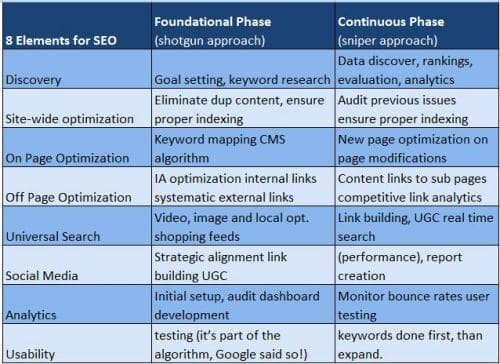It’s hard to keep up with the latest and greatest SEO tactics. Add thousands (or even millions of pages) and corporate hoops to jump though, and that is the hell an enterprise SEO point person deals with every day. Educating key decision makers, overcoming budget issues and keeping everyone on the same page were all challenges addressed at the Enterprise Level SEO session at Search Engine Strategies New York.
The session, moderated by Seth Besmertnik CEO of Conductor Inc, hosted a powerhouse panel of Ray “Catfish” Comstock Director of SEO at BusinessOnLine, Guillaume Bouchard Co-Founder and CEO of NVI and SES Advisory Board members, Bill Hunt President of Black Azimuth Consulting and SES Advisory Board member and Crispin Sheridan Senior Director of Search Marketing Strategy at SAP.
First up was Catfish.
Enterprise SEO Challenges
- Structure (what to do, sequence of activities)
- Internal logistics
- Research and development
- Reporting/analytics/how to measure success
Catfish provided an easy-to-use , easy-to-understand table for prioritizing SEO at an enterprise level.
Get your foundational keywords & SEO elements first, then expand.
Bill Hunt came up next to discuss what enables success in enterprise SEO programs.
- Challenges to Be Considered
- Many brands & products
- Multiple language versions
- Numerous SEO programs
- Wide range of roles to be included to make changes
- Enabler: Global Center of Excellence
- Enabler: Search Knowledge Bases
- Collect and share best practices with the wider team
- Enabler: Search Engine Style Guide
- A way to beat the agencies building your website into submission
- Forces people to comply
- Enabler: Keyword Management System
- Ensures focus on most important keywords
- Monitor keyword level performance across business units
- Monitor trends and opportunities
- Enabler: Always On – Critical Phrase Optimization
- Identify keywords and corresponding “preferred landing pages” (make sure it’s the right page!)
- Establish business rules to trigger page audits and PPC activities with Neo
- Ensures focus on most important keywords
- Enabler: Simplified Activity Reporting
- Identify 5 things you did this reporting period
- Identify 5 outcomes that moved the needle
- Identify 5 things you will do next reporting period
- Develop 3-5 minute video to highlight your reporting
- Share results, good or bad, with everyone
- Enabler: Deploy Business Unit Performance Metrics
- Leverage scorecards for governance to ensure consistent global performance goals are achieved
- Helps prioritize resource allocation
- Effectively blend paid search and natural search for brand awareness and lead generation
- Enabler: PR & Social Media Integration
- Most squandered opportunity in industry
- Share keywords and landing pages to ensure integration
- Generates the right links to key pages
- Enabler: Get a Handy Reference
- Search Engine Marketing, Inc.: Driving Search Traffic to Your Company’s Web Site
Sheridan gave his personal corporate experience at SAP, a large multinational software company with close to 50,000 employees and 12 million users in over 120 countries.
Issues
- Long sales cycle
- Large sites
- Multiple countries/language
- Challenges of educating key stakeholders
- Budgeting issues
- Implementation hurdles
- CMS issues
- IT team challenges
Start With Business Goals
- Branding, leads, sales
- Search efficiency
- Search synergy (PPC/SEO)
Prioritize Top Issues
- Multiple languages
- Duplicate content
- English (global, US, Americas, Canada, UK, NZ, Australia, etc.)
- Spanish (Spain, Mexico etc.)
- Complex content supply chains
- Differing models by country/region/product
- Lack of tools and skills
Select Enterprise SEO Tactics
- Content
- Keyword cluster research
- Keyword mapping = existing content + identify content gaps
- Localization/translation
- Local links
- Social media/ add this
- Local partners
- Canonical tagging
- Tell search engines which duplicate page is “master” to rank for that one
- Tools
- Training and education
Prioritize keywords with a cluster approach.
Next: Focused on Existing Content (“ah ha!”)
- Decision makers wanted key term “solutions for small business” = 1,000 searches/month
- BUT keyword research revealed more people search for “small business software” = 135,000/month
As Sheridan said, “Who cares what they want? Fish where there are fish!”
Net New Content: Harder Sell, Needed Proof
- Identify content gaps
- Create new content to match customer searches
- Demand generation optimized the landing page (akin to PPC landing pages)
- Convert at 2x site average
- Then, syndicate to multiple local language sites
- The proof in traffic and leads/ROI = buy-in and budget
Pay Attention to Universal SERPs
- Having a #1 rank with text link isn’t the end of the story…
- Blended search is huge- get a video in the SERPs, get maps into local
- These results push down competition and create a grander presence for your brand
Links: Deep & Local via “add this” and Outreach
- Allows users to share, bookmark and link
- Sheridan got 35,000 inbound links from this!
Tools: Insights & Recommendation Engine
- SEOlabs
SEO Driven Leads and Optimization Action
- Promote your successes!
Lastly, Bouchard gave hope to the little guy by comparing the advantages and disadvantages of both small and large companies. Lest we forget, size impacts SEO strategies.
Runner-Up Insights
- Smaller corporate structures and fewer departments involved…
- …are more agile, flexible
- …have less aversion to risk (but need to catch up with the leader)
- …are more open to make room for SEO to bridge gaps between them and the leading brand
- …have faster access and bigger impact on board members/key decision makers
- …dedicate a bigger chunk of the overall budget to SEO
- …face less risk of losing momentum
- …don’t have a lot of other properties available to leverage existing linkjuice
- …team up with other runner-ups and relevant verticals to compensate
- …leverage smart crowd sourcing in order to compete in terms of content (UGC)
Leader Insights
- Larger corporate structure and several departments…
- …have ridged development, security and a slower release cycle
- …have legacy products, which implies less bus model flex
- …have heavy aversion to risk
- …have short term management
- …usually focus on keeping pace vs. bridging gaps
- …have limited access and near irrelevancy toward board
- …allocate a small chunk of their budget to SEO
- …dumps SEO down the corporate chute – rarely a c-level project
- …have several existing properties to spread existing linkjuice
- …need to created global strategy
Bottom Line
With similar SEO budgets in absolute dollars:
- Runner-up will have a better product, and possibly be bought out
- Leader will lose momentum as stakeholders change and histories become lost or forgotten
- Both can reach similar results online, but runner-up will generate better results over time!
Advice for Runner-Up: Leverage that agility and flexibility. Use social media and crowd sourcing to your advantage..
Advice for Leaders: Keep up momentum at all cost. Ensure ideal transitions.
Makes you feel a little better about being small, huh? 🙂










